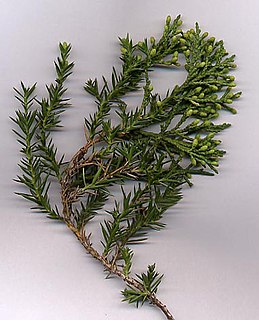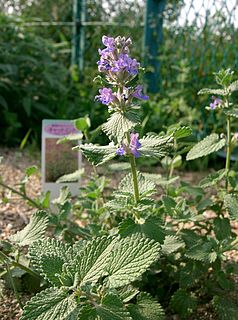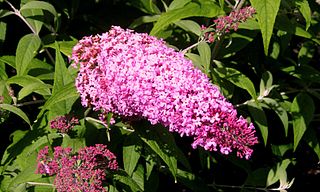
Geranium is a genus of 422 species of flowering annual, biennial, and perennial plants that are commonly known as the cranesbills. They are found throughout the temperate regions of the world and the mountains of the tropics, but mostly in the eastern part of the Mediterranean region.

Calluna vulgaris is the sole species in the genus Calluna in the flowering plant family Ericaceae. It is a low-growing perennial shrub growing to 20 to 50 centimetres tall, or rarely to 1 metre (39 in) and taller, and is found widely in Europe and Asia Minor on acidic soils in open sunny situations and in moderate shade. It is the dominant plant in most heathland and moorland in Europe, and in some bog vegetation and acidic pine and oak woodland. It is tolerant of grazing and regenerates following occasional burning, and is often managed in nature reserves and grouse moors by sheep or cattle grazing, and also by light burning.

Juniperus chinensis is a juniper that grows as a shrub or tree with a very variable shape, reaching 1–20 m tall. This native of northeast Asia grows in China, Mongolia, Japan, Korea and the southeast of Russia.

Nepeta × faassenii, a flowering plant also known as catmint and Faassen's catnip, is a primary hybrid of garden origin. The parent species are Nepeta racemosa and Nepeta nepetella.

Canna Italian Group 'Trinacria Variegata'. The earliest mention of this cultivar is in 1927, An Amateur in an Indian Garden by S. Percy-Lancaster, F.L.S., F.R.H.S., M.R.A.S., in which it was described and referred to by this name.

Canna Italian Group 'Roma' is a tall aquatic Italian Group cultivar, equally at home as a water marginal or in the border; large green foliage, oval shaped, white margin, upright habit; round stems, coloured green & purple; flowers are open, yellow with orange blotches, throat red-orange, staminodes are large, edges lightly frilled, stamen is orange-red, petals red, fully self-cleaning; seed is sterile, pollen is low fertile; rhizomes are long and thin, coloured white and pink; tillering is prolific. Introduced by C. Sprenger, Dammann & Co., Naples, Italy, EU in 1898.
Canna 'Phasion' is a medium sized Italian Group cultivar; green, bronze and pink variegated foliage, ovoid shaped, branching habit; oval stems, coloured red; clusters of flowers are open, tangerine-orange and burnt-red, staminodes are large, edges frilled, petals purple with farina, fully self-cleaning; seed is sterile, pollen is sterile; rhizomes are thick, up to 3 cm in diameter, coloured white and purple; tillering is average. Originally a spontaneous mutation, probably of Canna 'Wyoming', as it has been known to revert its foliage colour to that identical to that old cultivar. Sold in the US and elsewhere as Canna Tropicanna®, it was protected under US Plant Patent #10,569. Because the patent was issue on 1998-08-25, it has now expired and propagation is now allowed. The plant can be sold under its cultivar name Phasion.

Canna 'Florence Vaughan' is a medium Crozy Group canna cultivar; green foliage, oval shaped, branching habit; oval stems, coloured green; flowers are open, yellow with red spots, staminodes are medium size, edges regular, fully self-cleaning; fertile both ways, not self-pollinating or true to type, capsules globose; rhizomes are thick, up to 3 cm in diameter, coloured white; tillering is average. Introduced by A. Crozy, Lyon, France in 1892.

Canna 'Madame Crozy' is a medium-sized 'Crozy Group' canna cultivar; green foliage, large, ovoid shaped, branching habit; oval stems, coloured red; spikes of flowers are open, scarlet with a narrow gold margin, throat gold with vermilion spots, staminodes are medium size, edges regular, petals red, fully self-cleaning; fertile both ways, not true to type, self-pollinating; rhizomes are thick, up to 3 cm in diameter, coloured purple; tillering is prolific. It was introduced by A. Crozy, Lyon, France in 1890 and was named in honour of his wife. It was awarded the RHS Award of Garden Merit (AGM), in 1890.
Canna 'Bengal Tiger' is an Italian Group canna cultivar with variegated foliage; plant height 190 cm; foliage height 140 cm; upright stems and gently spreading leaves; ovoid foliage, background of green (137A); veins variegated yellow, but paler in places (13D); maroon edge to leaf; staminodes, labellum and stamen bright orange (28B) blushed a darker, reddish (32A) in places; yellow (15A) on edges; stigma deep orange-red; petals strongly flushed red. The flower has a crumpled silk appearance; seed and pollen has very low fertility levels; rhizomes thick, up to 3 cm in diameter.
Canna 'Yellow King Humbert' Burbank is a medium sized Italian Group Canna cultivar; foliage green, but often variegated purple markings and occasionally whole leaves purple, oval shaped, spreading habit; oval stems, coloured green + purple; flower clusters are open, spotted, colours yellow with red spots, often large red markings and occasionally whole flowers red, staminodes are large; seed is sterile, pollen is sterile; rhizomes are long and thin, coloured white and purple; tillering is prolific.
Canna 'Roi Humbert' is an Italian Group canna cultivar; bronze foliage, ovoid shaped, spreading habit; oval stems, coloured purple; flowers are cupped, self-coloured scarlet, staminodes are large, edges ruffled, fully self-cleaning; seed is sterile, pollen is sterile; rhizomes are thick, up to 3 cm in diameter, coloured purple; tillering is average. Introduced by C. Sprenger, Dammann & Co, Naples, Italy, EU in 1908.

Carl Ludwig Sprenger was a German botanist, born on 30 November 1846 at Güstrow, Mecklenburg and died 13 December 1917 on the island of Corfu (Kérkyra).

Pierre Antoine Marie Crozy (1831-1903) [also called Crozy aîné—French for "elder"] was a nineteenth-century French rose breeder. He was a partner in the French firm, Avoux & Crozy, La Guillotière, Lyon, actively breeding roses from the 1850s to 1860s. From the early 1860s until his death in 1903 he was also hybridising Canna species, and introduced many hundreds of new cultivars. The largest Canna Group today is still called the Crozy Group, and many of those cultivars are still being raised.

Buddleja 'Pink Delight' is a hybrid cultivar raised by the Horticultural Research Institute in Boskoop, Netherlands, in 1986 from the crossing B. davidii 'Fascination' × B. davidii var. nanhoensis 'Alba' × B. 'West Hill'. Accorded the Royal Horticultural Society Award of Garden Merit in 1993, 'Pink Delight' has become one of the most successful buddleja cultivars ever released and is still regarded as among the best pink-flowered varieties.














